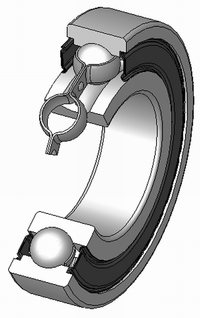
Photo from wikipedia
Wind turbines of larger power ratings have become increasingly prevalent in recent years, improving the viability of wind energy as a sustainable energy source. However, these large wind turbines have… Click to show full abstract
Wind turbines of larger power ratings have become increasingly prevalent in recent years, improving the viability of wind energy as a sustainable energy source. However, these large wind turbines have been subjected to higher rates of failure of the wind turbine gearbox, resulting in larger downtime of operation and an increase in cost due to repairs. These failures most frequently initiate in the gearbox’s bearings, especially in the planetary bearings of the planetary stage and high-speed bearings. Currently, most of the research on the detection of planetary bearing faults only addresses the case of localised faults in the outer bearing race, while fewer research considering the detection of distributed bearing faults. The research that does consider distributed bearing faults relies on techniques – such as machine learning for the identification of faulty bearings – that do not account much for the underlying physics of the bearing. In this paper, a model is developed to simulate and analyse the dynamic interaction of a planetary bearing in the presence of surface roughness, which can be used to represent a distributed fault. The model presented uses random vibration theory for simulating the response of the planet bearing induced by distributed faults. The input of the model considers statistical expressions of the roughness geometry using multiple parallel tracks. Numerical simulation of the random vibration of the model is performed using 16 tracks, and the power spectral density of the radial deflection of the roller and the roller–race contact force is determined. The results of the simulation with the multi-track model show that a single-track model significantly overestimates the power spectral densities, and also suggests the stiffness of the bearing race is too high to have an effect on the roller dynamics for a planet bearing.
Journal Title: Proceedings of the Institution of Mechanical Engineers, Part J: Journal of Engineering Tribology
Year Published: 2019
Link to full text (if available)
Share on Social Media: Sign Up to like & get
recommendations!